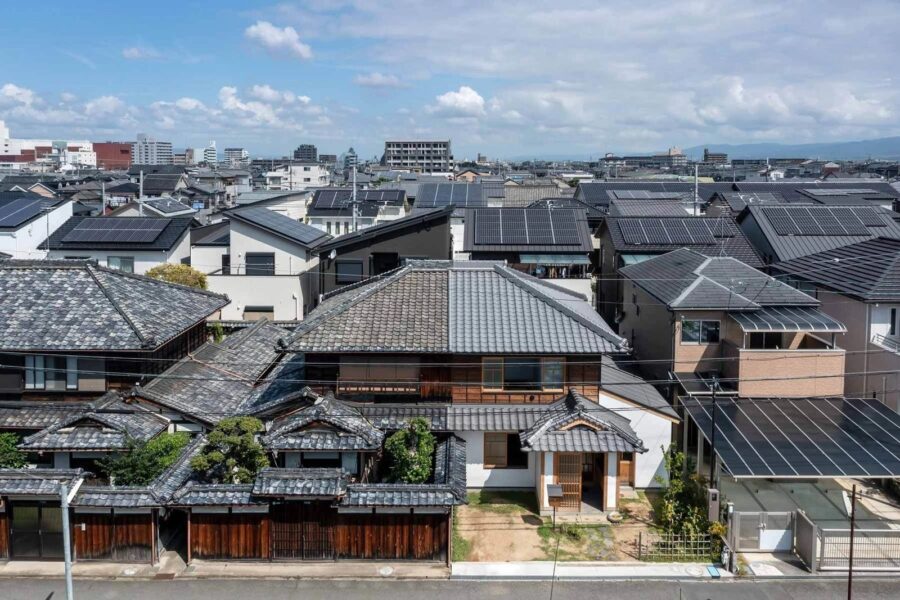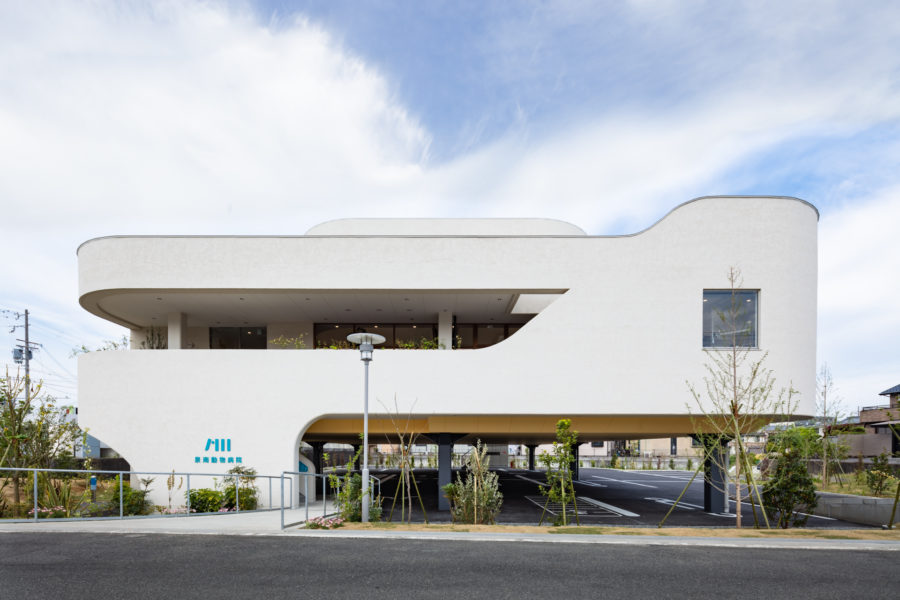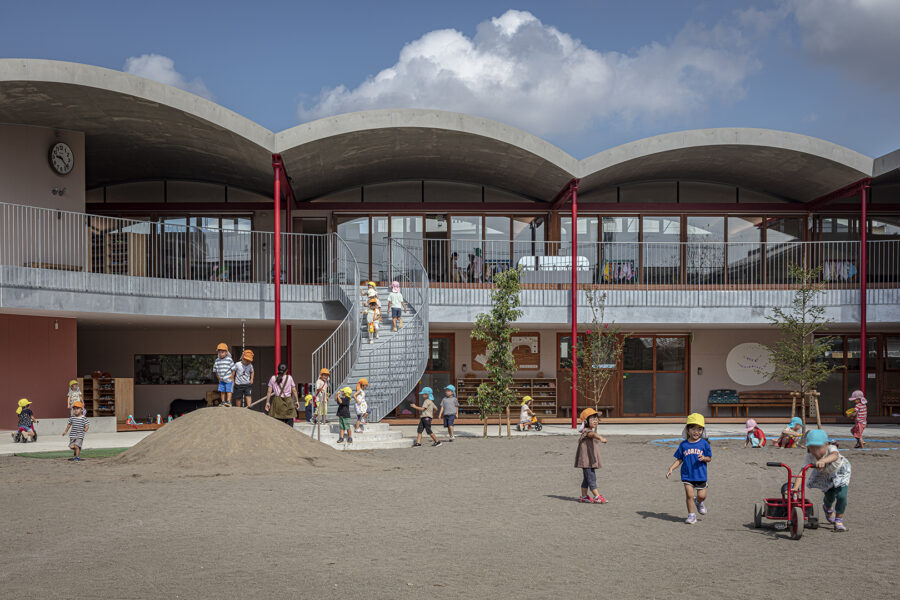東京に家を建てる
まさか東京に家を建てることになるとは思っていなかった。
息子が4歳を迎えようとするころだったか、妻が「家はどうする?」と。
広島と東京を行き来する生活の中で、数年前広島ではマンションを購入し、東京では賃貸での生活にも慣れた頃だった。
言うまでも無く東京の土地は高く、都内で家を所有することはないだろうと思っていたし、長く東京にいることも想像していなかったが、妻の一言で、東京で家を建てるという現実が、ある日突然やってきたのだった。
その日を境に、夜な夜なネットで敷地を探す日々が始まった。
これまで150件を超える住宅を設計してきたが、実際に自分が建てる側になるということは、とても貴重な経験なので、noteという有料ブログに少しずつアーカイブを残しながら、どのようにして家をつくるということが現実味を帯びていくのかということを書き残していくことにした。
言うまでもなく、ない袖は振れないわけで、一般的には世帯所得の5倍くらいが融資の限界と言われている中で、この地価の高い場所で敷地を探すとなると、自然と小さな敷地に狭小住宅を建てるという道が自然と出来上がっていた。仕事での移動を考えると、郊外に住むという選択肢は考えにくく、かといって都内となると坪300万円を超えるような敷地ばかりで、20坪の敷地でさえ6000万円を超えてくる。
建築費も高騰している状況を考えると、建坪率60%で12坪の3階建てで36坪。
坪単価150万円として、5400万円は工事費がかかり、不動産を所得するための手数料、税金もろもろを考えていくと、小さな敷地でも億を超えていくことが容易に想像出来た。
仮に1.2億円として考えても、頭金はさておき30年のローンで金利1%だとしても、月々38万円をこれから30年払い続ける。この現実を考えると、当時44歳だったので74歳までは働き続けなければならないということになる。
ローンを組んだとしても、今はおかげさまで日々忙しくさせて頂いているけれど、それがこれから30年も続いていく保証などどこにもない。そんな不安を誰もが抱えながら、マイホームを手に入れているのだという現実を、今さらながら施主になってはじめてリアルに感じたのだった。
それでも変形敷地などの悪条件な敷地であれば、坪単価も下がるだろうと考え、毎夜インターネットで、【狭小、変形敷地、傾斜地】などのキーワードを入れての検索を続ける日々が続いた。
自社で絶景不動産という不動産会社を経営をしているので、不動産業者専用サイトのレインズでも、都内で5000万円以下などの条件検索を繰り返していたが、なかなか思ったような条件では敷地に出会うことが難しく、見つかってもそこにこれから長く住み続けて行くことが想像出来ない敷地ばかりだった。
あるとき、自分の財布事情はひとまず置いておいて、もう少し広い敷地を探してみることにした。
すると、40坪~50坪くらいの敷地の情報がそれなりに出てきた。
住宅としてはある程度の所得がないと購入出来ない価格帯でありながらも、マンションなどのデベロッパーも、さほど世帯数を詰め込むことが出来ない、ある意味で手を出しにくい広さのレンジがそこにあるのかもしれないことが少しずつ理解出来てきた。
それまで利回りという言葉は知っていたが、具体的に何を意味するモノかは分からないまま、5%くらいなら都内だとよしとするみたいな認識しかなかったのだが、はじめてその利回りの算出方法も学び、賃貸と併用の事業モデルとして全体の計画を立ててみることにした。
商業系の地域は坪単価が高くなるため、住居系の地域で敷地を探しては測量図を取り寄せ、ラフプランをはめてみては自宅と賃貸併用での無理のない返済計画になっているかを、多くの敷地でトライアルを繰り返していった。
都内中心部、住宅系の用途地域で50坪程度の敷地だと、坪単価400万円程度で敷地で2億。建坪率60%で30坪 / 100m²の建坪で、容積率160%(前面道路4m想定)いっぱいまで建築できたとして、80坪。つまり3層の建築で30坪 / 100m²の1層、2層と3層目は20坪・66m²の室内と33m²のテラスの形態が導かれる。80坪 / 264m²を坪単価150万円で建築したとして、1億2千万円。土地建物で3.2億に対し、自己資金を2,000万円として、30年返済で金利を1%と見込むと月額964,000円。30坪 / 100m²を自宅として考え、残りの50坪 / 164m²を賃貸として、都心で坪2万円くらいの相場として、賃料が100万円。階数によって金額変動もあるとしても、自宅部分での費用負担を考えれば、無理のない支払い計画かつ、都内にある一定の広さを確保出来ることが分かった。
また万が一、仮に自分自身が働くことが出来なくなったとしても、自宅部分を賃貸にすることによって、ローンの支払いで困難な状況になることは避けることができる計画とした。
上記のような条件を前提とし、50坪前後で、道路斜線、日影に有利な敷地条件に絞り、敷地を探すという明確なゴールが見えてきた。エリアを絞り敷地を探しては測量図を取得し、計画をして事業収支を確認する、そんな筋トレのような日々を過ごした。
あるとき敷地を探していることを気に掛けてくれていた不動産関係の友人から電話がかかってきて、良さそうな敷地の販売情報が出ているよと写真が送られてきた。
そこにはカラーコーンに張り紙がされた、よく電信柱などに貼られている不動産情報と同類の内容があった。
正直、この手の張り紙に電話をすると電話の向こうに怖い人がいて、かけたら最後、無理矢理購入しなければならないみたいな、テレビでありそうなストーリーを勝手に想像していたので、怖くてかけることをためらったが、友人曰く大丈夫だからかけてみたらと背中を押され、恐る恐る電話をかけてみた。すると、あくまで電話口での印象だけれど、好印象な方が電話に出て、その不動産情報のことを丁寧に教えてくださった。
あいにく、その情報は僕の希望するモノではなかったのだけれど、都内の情報に明るい不動産会社さんだったので、後日お目にかかり、具体的な情報を伝えて敷地を探して頂くことにした。
数週間後、「とある場所にこれから敷地が売りに出される場所があるので見てください」と連絡をもらった。早速現地に足を運び周辺状況を確認した後、夜なべをして計画をした。何度も何度も繰り返しトライアルをしてきた空想の計画に限りなく近い状態で、建築を計画できると確信した。翌日、人生で始めての土地取得の申し込みを入れ、我々の都内での家づくりが始まったのだった。
具体的な計画として、掘り込み車庫のある段差の敷地に道路から直接入ることの出来る地下1階、階高を確保することで閉じながらも開放感をつくる2階、最大限持ち上げられた視界の抜ける3階のボリュームを立ち上げ、光の安定する北面採光を基本とした計画にすることにした。
間取りも将来的な可変性に対応出来るよう、外周部をコンクリート、内部に木造でボリュームを配した。個別性による作家性ではなく、画一的でありながらも作品として成立している誰もが住める状態を求め、プロポーションを検討し、平面・断面計画を行っていった。
今まで設計してきた家の対極とはいわないが、明るさよりも暗さをつくるために開口部の数を絞り、光のグラデーションをつくる。
細さよりは存在感を持たせ、薄さよりは厚みをつくり線の数はむしろ増やし陰影をつくり出す。
粗い材料を繊細に扱い、無機的ではなくマテリアルが主張する有機的な空間。
空調は用いず、夏は天井にルーバー状に配したパイプに冷水を通し涼を、冬は床下に温水を流し暖炉の火で暖をとる。
それは幼少期を過ごした町屋のように、鰻の寝床にある中庭を暗い室内から眺めていた原風景のようで、夏は水をうつことで気圧の変化によって風を起こして涼を得て、薪を割り五右衛門風呂にくべる、自然界にあるものを利用した過去の生活を現代に持ち込んだかのような空間だった。
柱や梁・砂壁の質感が暗く静かな空間に暖かみをもたらしていた空間体験は、コンクリートを荒々しくも繊細につくることで暖かいコンクリートとして再現し、不便で住みにくかった幼少期のネガティブな思い出は、時間を経て、むしろあの頃の空間風景をどこかで追い求めている自分がいた。
正直に話せば、良い建築をつくることよりも、どうやって家をつくることが出来るのかということが当初は主となっていたが、日頃どれだけ設計という行為がある意味で予算に納めるということは考えてはいるものの、建て主の経済環境までを理解して設計してきていないということを気づかされる経験でもあった。
建築家は依頼主によって決められた予算で建築をつくることにエネルギーを注ぐ。
しかし、その向こう側にある経済を想像したことがどれだけあっただろうか。
それは個人のクライアントであったとしても、商業系のプロジェクトであったとしても、その背景にある経済という仕組みを我々建築家が理解したとしたならば、時には提示された予算についても助言可能になるだろうし、よりそのプロジェクトにコミットできるようになっていくのではないだろうか。
建築をつくる以前と、つくった後のことまでもを、設計の範囲と考えたならば、きっと依頼主はそこまで考えてくれる建築家に仕事を依頼するだろう。
大きな金額が必要になる建築のプロジェクトだからこそ、経済と建築のバランスをも設計する、それが今後、我々に必要なことなのかもしれない。
良い建築をつくり、それに共感をして頂いて仕事を依頼して頂く。
僕自身も、心からそうありたいと思っている。
同時に、今回の自宅をつくるというプロジェクトを通して、建て主は、新しい新居への希望と経済不安のバランスの中で、建築がつくられていくのだと心から理解した。
経済活動と建築、どこかで分けてしまっていたこの関係を、今一度考え直し、良い建築について今後も考えていきたいと思う。
過去に思いを馳せるという感性を持ちながらも、現代だからこそ可能なエンジニアリングを駆使し、洞窟のような自然環境をここでは建築化した。
多くの迷いや挑戦の中で、過去の記憶と現在の思考が混ざり合い、以前からそこに建っていたかのように自邸は完成した。(谷尻 誠)
Movie: toha
A cave-like shadow and a warm home that has been reconsidered to the extent of the design
Building a House in Tokyo
I never thought that we would be building our house in Tokyo.
When my son was about to turn four years old, my wife asked me, “What about our house? I asked.
We had bought a condominium in Hiroshima a few years before and had gotten used to living in a rented house in Tokyo.
Land in Tokyo is expensive, and I thought I would never own a house in Tokyo, nor did I imagine staying in Tokyo for a long time, but with a word from my wife, the reality of building a house in Tokyo suddenly came to me one day.
After that day, I began to spend my days and nights searching for sites on the Internet.
I have designed more than 150 houses so far, but being on the actual builder’s side is a precious experience, so I decided to write about how the idea of building a home became a reality, leaving a little archive on a paid blog called “note.”
You can’t shake what you don’t have, and when it comes to finding a site in this high land price area, where it is generally said that about five times the household income is the limit for loans, they naturally created the path of building a small house on a remote site. Considering the need to travel for work, it was hard to imagine living in the suburbs, and if you were to go to Tokyo, you would have to pay over 3 million yen per tsubo for a site, and even 20 tsubos site would cost around 60 million yen.
Considering the soaring construction costs, a three-story house with a floor area of 12 tsubos at a building-to-land ratio of 60% would cost 36 tsubos.
Assuming 1.5 million yen per tsubo, the construction cost would be 54 million yen, and considering the fees and taxes for income from real estate, it was easy to imagine that the price would exceed 100 million yen even for a small site.
Even if we assume 120 million yen, we would have to pay 380,000 yen per month for the next 30 years, even if the down payment is aside and the interest rate is 1% for a 30-year loan. Considering this reality, I was 44 years old at the time and would have to keep working until I was 74.
Even if I took out a loan, I would keep myself busy, but there is no guarantee that this will continue for the next 30 years. After becoming the owner of the house, I realized the reality that everyone is getting their own home with such anxiety.
Even so, I thought that the price per tsubo would be lower if the site were in bad condition, such as a deformed site, so I continued to search the Internet every night using keywords such as “narrow, deformed site, sloping site.”
Since running my own real estate company called Spectacular Real Estate, I repeatedly searched for sites in Tokyo for less than 50 million yen on the real estate agent’s website Raines. Still, it was challenging to find a place with the conditions I wanted, and even if I did, I could not imagine living there for a long time.
One day, I decided to look for a larger site, leaving my financial situation aside for the time being.
Then, I found a fair amount of information about sites of about 40 to 50 tsubos.
I gradually realized that there might be a range of difficult sizes to reach in a sense where developers of condominiums, etc., cannot cram as many households as possible. In contrast, the price range is such that you need a certain amount of income to buy a house.
Until then, I had known the word “yield,” but I had only been aware that about 5% would be acceptable in Tokyo without knowing what it specifically meant. For the first time, I learned how to calculate the yield and decided to make an overall plan as a business model for both renting and selling.
Since the price per tsubo (square meter) was higher in commercial areas, I looked for sites in residential areas, ordered survey maps, made rough plans, and repeated trials with many places to see if I could make a reasonable repayment plan for the combination of home and rental.
For a site of about 50 tsubos in a residential zoning district in the center of Tokyo, the cost per tsubo was about 4 million yen, and the site cost 200 million yen. With a building-to-land ratio of 60% and a floor-area ratio of 160% (assuming a 4-meter front road), that would be 80 tsubos. In other words, a three-story building would have the first floor of 30 tsubo / 100 m², a second floor and the third floor of 20 tsubos / 66 m² of interior space, and a terrace of 33 m². If we assume that the interest rate is 1% for a 30-year repayment, the monthly rent would be 964,000 yen. Thirty tsubos / 100m² is considered a home, and the remaining 50 tsubos / 164m² is a rental. The rent would be 1,000,000 yen, which is about 20,000 yen per tsubo in the city center. Even if the amount of money fluctuates depending on the number of floors, considering the home part’s cost burden, I knew that I could secure a certain amount of space in Tokyo with a reasonable payment plan.
In addition, even if I were unable to work, I would avoid difficulties in paying the loan by renting my house.
With the above conditions in mind, I narrowed my search to a site with a floor area of around 50 tsubos and favorable road diagonals and shade. I spent my days like a muscle train, searching for a site in a specific area, obtaining a survey map, making a plan, and confirming the business income and expenditure.
One day, I received a phone call from a friend in the real estate industry concerned about my search for a site, and he sent me a picture of a place that looked good.
He sent me a picture of it, saying that there was information about a sale site that looked good. There was a sign on a colored cone, the same kind of real estate information often posted on telegraph poles.
I was hesitant to call the number because I imagined a story like the one on TV, where if you call this kind of sign, there is a scary person on the other end of the phone, and you have to force yourself to buy the house. So I made the call. Then, although it was just my impression over the phone, a person with a good impression answered the phone and politely told me about the real estate information.
Unfortunately, the information was not what I was looking for, but since the real estate company was very knowledgeable about information in Tokyo, I decided to meet with them later to give them specific knowledge and have them look for a site for me.
A few weeks later, I received a call from the company saying, “There is a site for sale in a certain area, so please take a look.” I immediately went to the site to check out the surrounding area and then worked overnight to plan. I was convinced that I could design the architecture as close as possible to the imaginary scenario that I had tried repeatedly. The next day, we put in an application to acquire land for the first time in our lives, and our house building in Tokyo began.
As a detailed plan, we decided to build a basement floor directly accessible from the road on a stepped site with a dug-in garage, a second floor that creates a sense of openness even though it is closed off by securing a high floor, and the third floor with a maximally raised view.
I designed the floor plan to be variable in the future, with the perimeter made of concrete and the interior made of wood. I studied the building’s proportions, and I made the plan and cross-sectional plans hoping that anyone could live in the house.
Although it is not the opposite of the houses I have designed in the past, I narrowed down the number of openings to create darkness rather than lightness and created a light gradation.
To create a sense of presence rather than thinness, create thickness rather than thinness, increase the number of lines rather than decrease them, and create shadows.
Coarse materials are handled delicately, and the space is not inorganic but organic, with materials asserting themselves.
No air-conditioning is used; cold water is passed through louvered pipes on the ceiling to cool the room in summer, and warm water is given under the floor to warm the room by the fireplace in winter.
Space was like the townhouse’s original landscape where I spent my childhood, looking out from a dark room at the courtyard in a long, narrow space like an eel’s bed. In summer, water is sprinkled on the floor to create a breeze to cool the air due to the atmospheric pressure change. We chopped and burned wood to boil water for the bath. It was as if they had brought the past lifestyle, which made use of things found in nature, into the present.
The spatial experience, where the pillars, beams, and sand walls’ texture brought warmth to the dark and quiet space, was recreated as warm concrete by making the concrete rough but delicate. The negative memories of an inconvenient and difficult childhood to live in had passed over time, and I found myself instead of pursuing the spatial landscape of those days somewhere else.
My main concern was how to build a house rather than how to create exemplary architecture, but it was also an experience that made me realize how much I think about the act of designing in the sense of keeping within a budget. Still, I have not designed with an understanding of the economic environment of the client.
Architects focus their energy on creating buildings within the budget set by the client.
However, how often have we imagined the economy that lies beyond that?
Whether it is a private client or a commercial project, if we as architects understood the economic system behind the project, we would advise the client on the proposed budget and be more committed to the project.
If the design scope includes both before and after the building’s construction, then the client will probably commission an architect who will consider this.
It is precise because architectural projects require large sums of money that may be necessary for us to design a balance between economics and architecture.
We need to create exemplary architecture, and if people feel sympathy for it, they will ask us to work on it.
That is what I sincerely want to do myself.
At the same time, through this project of building my own house, I understand that architecture is created in a balance between the builder’s hopes for a new home and economic anxiety.
I want to reconsider this relationship between economic activities and architecture, which I have somehow separated, and continue to think about good architecture.
While maintaining the sensibility of thinking back to the past, I have made full use of engineering that is possible only in the modern age and have transformed a natural environment like a cave into architecture.
Through many hesitations and challenges, the memories of the past and the thoughts of the present blended, and my own house was completed as if it had always stood there. (Makoto Tanijiri)
【HOUSE T】
所在地:東京都
用途:併用住宅
クライアント:谷尻 誠
竣工:2020年
設計:SUPPOSE DESIGN OFFICE
担当:谷尻 誠、濱谷明博
構造設計:堀江建築設計事務所
家具:E&Y+SET UP+TIMBER CREW
設備設計:島津設備設計事務所
照明設計:Filaments+ModuleX
植栽:SOLSO
施工協力:賀茂クラフト+SET UP
施工:21世紀工務店
撮影:矢野紀行
工事種別:新築
構造:RC造
規模:地上2階 地下1階
敷地面積:175.60m²
建築面積:115.20m²
延床面積:285.36m²
設計期間:2018.05-2019.02
施工期間:2019.02-2020.08
【HOUSE T】
Location: Tokyo, Japan
Principal use: Residential
Client: Makoto Tanijiri
Completion: 2020
Architects: SUPPOSE DESIGN OFFICE
Design team: Makoto Tanijiri, Akihiro Hamatani
Structure engineer: Horie Architect Office
Furniture: E&Y + SET UP + TIMBER CREW
Facility design: Shimazu Design Office
Lighting design: Filaments + ModuleX
Planting: SOLSO
Construction cooperation: Kamo craft + SET UP
Contractor: Twenty-first century constructions
Photographs: Toshiyuki Yano
Construction type: New building
Main structure: Reinforced Concrete construction
Building scale: 2 stories and 1 below
Site area: 175.60m²
Building area: 115.20m²
Total floor area: 285.36m²
Design term: 2018.05-2019.02
Construction term: 2019.02-2020.08








